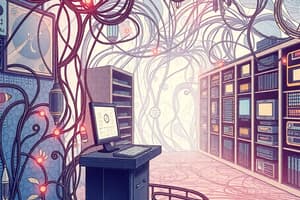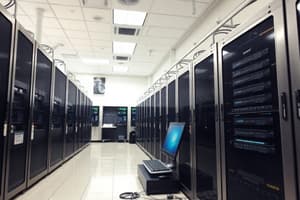Podcast
Questions and Answers
Which feature of web browsers allows users to save and easily return to web pages?
Which feature of web browsers allows users to save and easily return to web pages?
- Bookmarking (correct)
- History management
- Browser caching
- Security settings
What is the primary purpose of CSS in web technologies?
What is the primary purpose of CSS in web technologies?
- To program dynamic functions for websites
- To create interactive forms
- To control presentation and formatting of web pages (correct)
- To manage server-side data
Which statement accurately describes JavaScript's role in web development?
Which statement accurately describes JavaScript's role in web development?
- It is primarily used for database management.
- It is used for static web page creation.
- It adds interactivity and dynamic behavior to web pages. (correct)
- It serves as a server-side programming language.
Which of the following is a potential threat to data security?
Which of the following is a potential threat to data security?
What is an essential requirement for success in ICT-related careers?
What is an essential requirement for success in ICT-related careers?
In the context of web pages, what differentiates a web page from a website?
In the context of web pages, what differentiates a web page from a website?
What describes the primary purpose of the information processing cycle?
What describes the primary purpose of the information processing cycle?
Which skill is crucial for professionals in the rapidly evolving ICT field?
Which skill is crucial for professionals in the rapidly evolving ICT field?
What is a primary goal of data integrity measures?
What is a primary goal of data integrity measures?
Which factor is NOT typically considered in the characteristics of programming languages?
Which factor is NOT typically considered in the characteristics of programming languages?
Which of the following is a step involved in problem-solving techniques?
Which of the following is a step involved in problem-solving techniques?
What is essential for ensuring security in database systems?
What is essential for ensuring security in database systems?
Which concept is NOT a part of programming constructs?
Which concept is NOT a part of programming constructs?
What is the primary function of HTML in web design?
What is the primary function of HTML in web design?
Which of the following statements about CSS is true?
Which of the following statements about CSS is true?
What is the purpose of mail merge in document creation?
What is the purpose of mail merge in document creation?
Which of the following describes a database management system (DBMS)?
Which of the following describes a database management system (DBMS)?
What kind of tasks can spreadsheets be used for?
What kind of tasks can spreadsheets be used for?
What is a key benefit of using HTML tags?
What is a key benefit of using HTML tags?
How are multimedia elements integrated into web pages?
How are multimedia elements integrated into web pages?
What do database reports typically accomplish?
What do database reports typically accomplish?
Flashcards
Computer Network
Computer Network
A group of connected devices that can share information and resources.
Web Browser
Web Browser
Software used to view web pages on the internet.
Web Page
Web Page
A single document on the internet.
Website
Website
Signup and view all the flashcards
HTML
HTML
Signup and view all the flashcards
System Software
System Software
Signup and view all the flashcards
Application Software
Application Software
Signup and view all the flashcards
Data vs. Information
Data vs. Information
Signup and view all the flashcards
Data Integrity & Security
Data Integrity & Security
Signup and view all the flashcards
Problem-Solving Techniques
Problem-Solving Techniques
Signup and view all the flashcards
Algorithms and Flowcharts
Algorithms and Flowcharts
Signup and view all the flashcards
Programming Languages
Programming Languages
Signup and view all the flashcards
Variables, Data Types, Operators
Variables, Data Types, Operators
Signup and view all the flashcards
Mail merge
Mail merge
Signup and view all the flashcards
HTML tags
HTML tags
Signup and view all the flashcards
CSS
CSS
Signup and view all the flashcards
Spreadsheet Cell
Spreadsheet Cell
Signup and view all the flashcards
Database
Database
Signup and view all the flashcards
Database Management System (DBMS)
Database Management System (DBMS)
Signup and view all the flashcards
Cell Referencing
Cell Referencing
Signup and view all the flashcards
Database Table
Database Table
Signup and view all the flashcards
Study Notes
Computer Fundamentals and Information Processing
- A computer system is an integrated unit of hardware, software, and peripheral devices working together to process data and produce information.
- Input devices allow users to enter data (e.g., keyboard, mouse, scanner).
- Output devices display or print processed information (e.g., monitor, printer).
- The Central Processing Unit (CPU) performs data processing and instruction execution.
- Storage devices (RAM, ROM, hard disk, optical disks, USB drives, cloud storage) store data and programs.
- Desktop computers are stationary, while laptops are portable and battery-powered.
- Tablets are portable touch-screen devices.
- Smartphones combine phone and computer functionalities.
- Servers provide services and resources to other computers on a network.
- Mainframe computers are large, powerful computers used for critical applications and data processing.
- Computer hardware includes physical components (motherboard, CPU, memory, storage devices, input/output devices).
- Computer software includes programs and instructions that run on hardware (operating system, application programs, system utilities).
Storage
- RAM (Random Access Memory) provides temporary storage for data and instructions currently being processed by the CPU.
- ROM (Read-Only Memory) stores basic instructions for starting up and performing fundamental functions.
- Hard disk drives use magnetic storage for long-term data storage.
- Optical disks (CDs, DVDs) use laser technology to store and retrieve data.
- USB drives are portable, removable storage devices using flash memory.
- Cloud storage is online storage accessed remotely.
- Storage units are measured in bytes, kilobytes (KB), megabytes (MB), gigabytes (GB), and terabytes (TB) (1KB=1024 bytes, 1MB=1024KB, 1GB=1024MB, 1TB=1024GB).
Input and Output Devices
- Keyboards allow text and command input.
- Mice enable pointing, selecting, and manipulating on-screen objects.
- Scanners convert physical documents into digital files.
- Webcams capture images or video.
- Microphones capture audio input.
- Monitors display computer output (text, graphics, multimedia).
- Printers produce hard copies of documents, images.
- Speakers output audio (music, sound effects, etc.).
- Projectors display computer output on a large screen.
Number Systems
- Decimal (base 10): The everyday number system (0-9).
- Binary (base 2): Used by computers (0 and 1).
- Hexadecimal (base 16): Often used in programming (0-9 and A-F).
Computer Networks and the Internet
- A computer network connects devices for communication and resource sharing.
- LAN (Local Area Network): Covers a small area (home, office).
- WAN (Wide Area Network): Covers a large geographical area (country, continent).
- MAN (Metropolitan Area Network): Covers a city or metropolitan area.
- Network components: routers, switches, modems, servers, clients.
- Internet services include the World Wide Web, email, and instant messaging.
Web Technologies
- Web browsers are software used for accessing the World Wide Web.
- Web pages are individual documents.
- Websites are collections of related web pages.
- HTML (Hypertext Markup Language) structures and formats web pages.
- CSS (Cascading Style Sheets) styles web pages (layout, colors, fonts, etc.).
- JavaScript adds interactivity and dynamic behavior to web pages.
Social and Economic Impact of ICT
- System software (operating systems, device drivers, utility programs) manages computer hardware and provides user interfaces.
- Application software includes word processors, spreadsheets, databases, multimedia applications, and programming tools.
- Processing modes: Batch processing (data processed in groups), online processing (data processed immediately), and real-time processing (instantaneous data processing).
- Data vs Information (Raw facts vs Processed meaningful data.)
- Data Security includes Threats (viruses, malware, hacking, unauthorized access).
- Data backup and recovery (Regular data backups and disaster recovery plans).
- Encryption and access control (protecting data from unauthorized access.)
Word Processing and Web Page Design
- Word processing involves creating, editing, and formatting documents. Functions include inserting and manipulating objects (images, tables, charts). Mail merge creates personalized documents.
- Web page design uses HTML for structure and CSS for style, with multimedia elements (images, audio, video).
Spreadsheets
- Spreadsheets organize data in cells, rows, and columns.
- Formulas and functions perform calculations.
- Formatting, styles, and themes enhance spreadsheet appearance and readability.
- Spreadsheet applications involve data entry, manipulation, and analysis, including sorting, filtering, grouping, chart/graph generation, and report creation.
Database Management
- Databases are organized collections of electronically stored data.
- Database Management Systems (DBMS) are software for creating, maintaining, and accessing databases.
- Tables, comprising records (rows) and fields (columns), structure databases.
- Data types define the attributes of stored data.
Problem-Solving and Program Design
- Problem-solving techniques involve identifying and defining the problem, gathering relevant information, analyzing information to find patterns or causes, and creating and evaluating potential solutions.
- Algorithms are step-by-step procedures for solving problems. Flowcharts visualize these algorithms. Pseudocode describes algorithms in a mix of natural language and programming syntax.
- Basic programming constructs are sequence (statements executed in order), selection (using conditional statements, making decisions based on conditions), and iteration (repeating statements using loops)
- Programming concepts include variables (storage locations for values), data types (classifying data), and operators (symbols used for operations). Input/output operations involve receiving data from users or external sources and displaying or storing results.
Studying That Suits You
Use AI to generate personalized quizzes and flashcards to suit your learning preferences.




